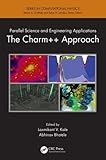Parallel science and engineering applications : the Charm++ approach / edited by Laxmikant V. Kale, Abhinav Bhatele. [electronic resource]
Material type: TextSeries: Series in computational physicsPublisher: Boca Raton : CRC Press, [2014]Copyright date: ©2014Description: 1 online resource (302 pages) : illustrations (some color), portraitsISBN:
TextSeries: Series in computational physicsPublisher: Boca Raton : CRC Press, [2014]Copyright date: ©2014Description: 1 online resource (302 pages) : illustrations (some color), portraitsISBN: - 9781466504134 (e-book)
- Charm++ approach
- 502.855133
- TA345.5.P37 P37 2014
| Item type | Current library | Call number | Status | Date due | Barcode | |
|---|---|---|---|---|---|---|
| Ebook | TUS: Midlands, Main Library Athlone Online | eBook (Browse shelf(Opens below)) | Available |
Includes bibliographical references and index.
1. The Charm++ programming model / Laxmikant V. Kale and Gengbin Zheng -- 2. Designing Charm++ programs / Laxmikant V. Kale -- 3. Tools for debugging and performance analysis / Filippo Gioachin, Chee Wai Lee, Jonathan Lifflander, Yanhua Sun and Laxmikant V. Kale -- 4. Scalable molecular dynamics with NAMD / James C. Phillips, Klaus Schulten, Abhinav Bhatele, Chao Mei, Yanhua Sun, Eric J. Bohm and Laxmikant V. Kale -- 5. OpenAtom : Ab initio molecular dynamics for petascale platforms / Glenn J. Martyna, Eric J. Bohm, Ramprasad Venkataraman, Laxmikant V. Kale and Abhinav Bhatele -- 6. N-body simulations with ChaNGa / Thomas R. Quinn, Pritish Jetley, Laxmikant V. Kale and Filippo Gioachin -- 7. Remote visualization of cosmological data using salsa / Orion Sky Lawlor and Thomas R. Quinn -- 8. Improving scalability of BRAMS : a regional weather forecast model / Eduardo R. Rodrigues, Celso L. Mendes and Jairo Panetta -- 9. Crack propagation analysis with automatic load balancing / Orion Sky Lawlor, M. Scot Breitenfeld, Philippe H. Geubelle and Gengbin Zheng -- 10. Contagion diffusion with EpiSimdemics / Keith R. Bisset, Ashwin M. Aji, Tariq Kamal, Jae-Seung Yeom, Madhav V. Marathe, Eric J. Bohm and Abhishek Gupta.
"This volume highlights the use of Charm++ in a wide variety of scientific and engineering fields. It emphasizes the adaptivity, asynchrony, and message-driven execution and proposes design choices for application development. With illustrative examples throughout, the text describes associated tools, parallelization strategies, and parallel performance. It also explains the requirements for writing any computational science and engineering application, including those related to molecular dynamics, quantum chemistry, cosmological simulations and visualizations, and weather simulations"-- Provided by publisher.
Description based on print version record.
Electronic reproduction. Ann Arbor, MI : ProQuest, 2015. Available via World Wide Web. Access may be limited to ProQuest affiliated libraries.
